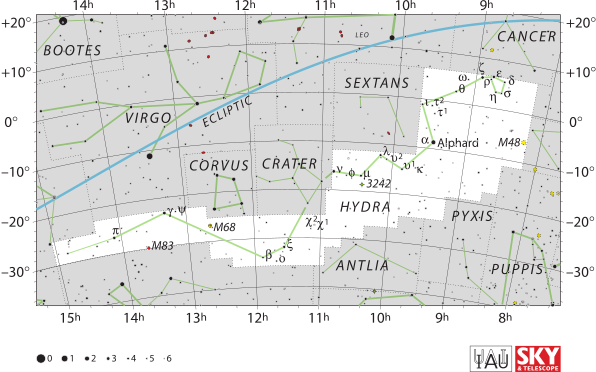The largest of the 88 modern constellations, Hydra measures 1303 square degrees. Neighboring constellations include Libra, Centaurus, and Cancer. It was included among the 48 constellations listed by the 2nd century astronomer Ptolemy and is commonly represented as a water snake. It is located in the southern hemisphere and can be seen at latitudes between +54° and -83°.
| Applicable Information | |
| Visibility In Pacific Northwest | October to April |
| Best Times To View | April |
| Right Ascension | 8h– 15h |
| Declination | −20° |
| Area | 1303 square degrees |
| Main Stars | 17 |
| Brightest Object | Alphard (α Hya) |
| Meteor showers | Alpha Hydrids; Sigma Hydrids |
| Messier objects | 3 |
| Neighboring Constellations | Antlia, Cancer, Canis Minor, Centaurus, Corvus, Crater, Leo, Libra, Lupus, Monoceros, Puppis, Pyxis, Sextans, Virgo, |
Myths
The Babylonian constellation inspired the Greek to adapt Hydra as a constellation. MUL.APIN is one of two Babylonian “serpent” constellations, with the other constellation being the origin of the Greek Serpens. MUL.APIN is a mythological hybrid of serpent, lion and bird.
The shape of Hydra resembles a twisting snake, which features in Greek myths. 1 such myth associates Hydra with a water snake that a crow served Apollo in a cup when it was sent to fetch water; Apollo saw through the fraud, and angrily cast the crow, cup, and snake, into the sky. It is also associated with the monster Hydra, with its many heads, killed by Hercules, represented in another constellation.
According to a different legend, if one of the Hydra’s heads was cut off, two more would grow in its place. However, Hercules’ nephew, Iolaus, seared the necks with a torch to prevent them from growing back and thus enabled Hercules to overcome the Hydra.
In Hindu Mythology, the star Ashlesha is equivalent to the Greek Hydra. In Chinese astronomy, the stars that correspond to Hydra are located within the Vermilion Bird and the Azure Dragon.
Stars
Despite the large size, Hydra contains 1 moderately bright star, Alphard, which is designated Alpha Hydrae. It is an orange giant of magnitude 2.0, with a name that means “the solitary one”.
Hydra has one bright binary star, Epsilon Hydrae, which can be difficult to split in amateur telescopes
Hydra contains three Messier objects. M83, also known as the Southern Pinwheel Galaxy, is located on the border of Hydra and Centaurus, M68 is a globular cluster near M83, and M48 is an open star cluster in the western end of the serpent.
NGC 3242 is a planetary nebula of magnitude 7.5, which was discovered in 1785 by William Herschel. It earned the nickname “Ghost of Jupiter” because of its striking resemblance to the giant planet, and its blue-green disk is visible in small telescopes and its halo is visible in larger instruments.
M48, otherwise known as NGC 2548, is an open cluster that is visible to the naked eye under dark skies, and has been described having a “triangular” shape. This 80-star cluster is unusually large, more than half a degree in diameter, larger than the diameter of the full Moon.
Hydra has several globular clusters, some of which are visible by amateur astronomers in their telescopes. M68, otherwise known as NGC 4590, is a globular cluster visible in binoculars and resolvable in medium amateur telescopes. NGC 5694 is a globular cluster of magnitude 10.2, 105,000 light-years from Earth.
M83, otherwise known as NGC 5236, the Southern Pinwheel Galaxy, is an 8th magnitude face-on spiral galaxy. It is easily observed in skies south of 40°N latitude, found by using 1, 2, 3, and 4 Centauri as guide stars. M83 has 6 supernovae in it, which is more than any Messier object. Large amateur telescopes, >12 inches aperture reveal its spiral arms, bar, and small, bright nucleus, whereas 8 inch medium sized amateur telescopes can see the spiral arms under good conditions.
There are many other galaxies located in Hydra. NGC 3314 is a pair of galaxies that appear superimposed, despite the fact that they are not related or interacting in any way.
Make sure to check out other articles on the site, including a brief introduction to constellations, other constellation articles, and more!

Be the first to comment on "Hydra"